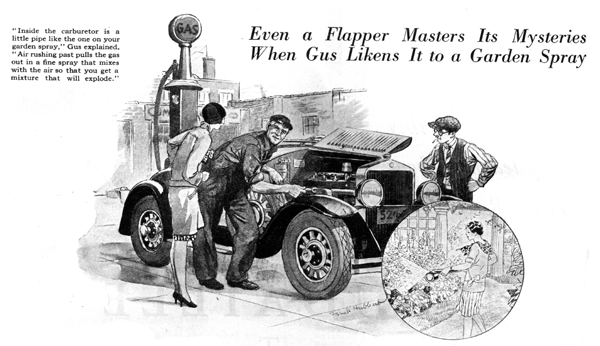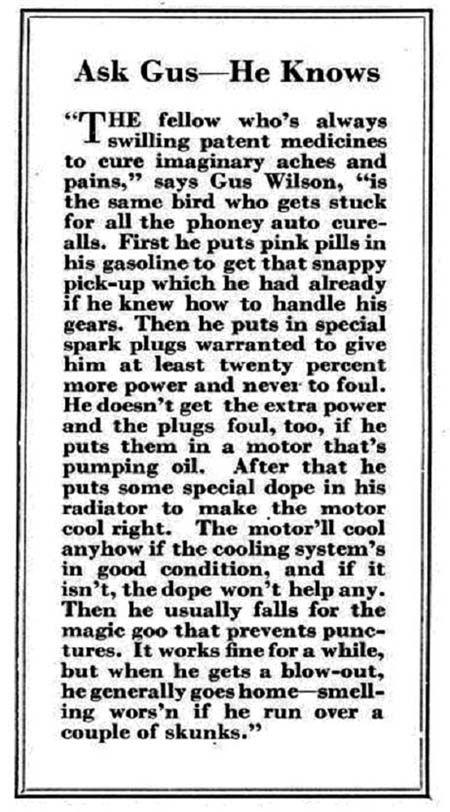June 1929
DO YOU KNOW YOUR CARBURETOR?
by Martin Bunn

"How is your wife making out driving the car these days?" Gus Wilson, veteran mechanic of the Model Garage, asked his partner.
Joe Clark, bookkeeping member of the firm laughed disgustedly, "That woman will never learn anything," he growled. "Why is it so hard to teach 'em about cars?"
"Maybe you haven't found the secret yet," suggested Gus.
"What secret?" Joe asked curiously.
"Well," Gus replied with a twinkle in his eye, "it's the same as teaching tricks to a dog -- first first you've got to know more than the dog!"
"You insulting son-of-a-gun!" grinned Joe as he threw a grimy piece of waste which just missed his partner's head.
"Seriously, though," said Gus, "most people don't know how to explain things about a car to a woman. Now, if I had to do it -- "
"Oo -- ee! Mr. Wilson!" a lilting feminine voice interrupted Gus's sage remarks.
Joe looked out, and turned to his partner with a sly smile.
"It's Judge Bond's daughter," he reported. "She has a brand-new roadster. Do your stuff now if you know so much about teaching the flappers!"
Marianne Bond was bubbling over with excitement when she entered the garage. "What do you think of it?" she demanded, indicating her new car.
"Daddy just gave it to me and I thought I'd ask you to tell me all about how it works so if anything went wrong I'd know what to do."
"That's rather a large order, young woman," Gus smiled, while Joe almost choked stifling a guffaw.
Gus stood in thoughtful silence for a moment while Marianne surveyed him expectantly.
"You know what the carburetor is, of course?" the veteran mechanic asked suddenly.
"Why, yes, of course," responded the girl brightly, "Hasn't that got something to do with putting gasoline in the motor?"
"Something," admitted Gus gravely.
"By the way," he added after a moment, "didn't I see you spraying some plants in your garden the other day?"
"Yes -- rose bushes," replied Marianne, puzzled by the apparent irrelevance of the question.
"Know how the spray works?" Gus asked.
"Surely, Mr. Wilson. The air just rushes out the end of the pipe so fast it sucks the liquid out of the little pipe as it goes by. But what has that got to do with carburetors?"
"The carburetor works the same way," Gus explained, "Inside the carburetor is a little pipe like the one on your spray, and when the air rushes past it puffs the gas out in a fine spray that mixes with the air so you get a mixture that will explode when a spark hits it.
"You know what happens to the garden spray when you have it too full?" Gus questioned.
"You get an awful thick spray," Marianne replied.
"Same thing with the carburetor," Gus stated. "If you open the adjustment too far you let the spray get so thick it doesn't explode right. When the garden spray is nearly empty you have to pump harder to get any spray at all. It's the same in the carburetor. If you close the adjustment too far, you get a thin mixture that won't burn."
"Why that's just too simple for anything," exclaimed Marianne. "Is that all there is to the carburetor?"
"That's all there would be if the motor always ran at the same speed," Gus told her. "But you know how sometimes the motor just barely turns over while you are waiting in traffic, and the next minute you're scooting down the road with the motor humming like a bumblebee. If you think about that garden spray again, you'll see what I mean. If you push the handle back and forth real slow, you don't get any spray at all, and then when you work it faster, all of a sudden it starts to work fine. If the carburetor worked like that the motor would stop every time you took your foot off the throttle. The throttle of course is just a valve that regulates the amount of air rushing through the carburetor. Most all of the complications in a carburetor are to make it spray the right amount of gasoline into the air no matter how fast the air goes by.
One way they get that result is to make the air passage around the jet real small. Then they fix it so all the air goes through that small passage when the throttle is nearly shut. As the throttle is opened, more and more air is drawn in through another valve that opens in proportion to the amount of suction. In some carburetors they use two jets. One works all the time whether the motor is idling or racing, but the other only works when the throttle is open and lots of air is rushing through the carburetor. That's the way the carburetor on this car is made.
"That's about all there is to the theory of carburetors," Gus went on," except about the float chamber. You know how nice your garden spray works when you have just the right amount of liquid in it. The carburetor is the same and to keep just the right amount of gasoline in it all the time, this float chamber here keeps the level of gasoline always the same no matter how fast or slow the gasoline is drawn through the jets. The float inside it works a needle valve, so when the gasoline flows into the chamber and lifts the float it shuts the valve. When gasoline is drawn out of the float chamber the float naturally drops a bit and opens the valve again and more gasoline runs in."
"Isn't it just too thrilling!" said Marianne. "Now when I get stuck all I've got to do is turn those funny little knobs to get a better adjustment and it'll start again just as easy!"
"That's just exactly what you mustn't do," Gus commanded. "The first thing you do when you get stuck on the road is to see if you've got any gas in the tank. Then you can tickle this float button and if gasoline runs out of the bottom of the carburetor look for the trouble somewhere else. Chances are ten to one it isn't in the carburetor at all. Lots of people think the carburetor is to blame for most stops on the road and right away they start tinkering with it till they get it all out of whack.
"About all that can happen to a carburetor is to have the jets get clogged or the float spring a leak and sink. Generally you can clear clogged jets by jamming your foot on the throttle and pulling the choke all the way on for a couple of seconds. The extra suction drags the dirt or water right through.
"There's no way to fix a leaky float except to take it out and solder the hole, but usually the motor will keep on running after a fashion so you can get to a service station, anyhow.
"Now run along, young lady, Joe and I have a job that's got to be finished before noon. Right now you know more about carburetors than most men do! Drop in again and we'll take up some other part of the car.
"Well," he remarked to Joe as Marianne's roadster rolled through the doorway, "as I told you before, it's just a matter of knowing more than the dog!"
END
L. Osbone 2019
